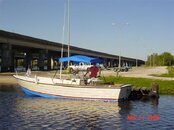This might be interesting to some.
Small Boat Safety at Sea: Boat Safety at Sea
I don't completely agree with nor think the article is complete but it is a good read. I would rather assume water will come in the boat and give it no place to go but back out using buoyancy and gravity to clear the water, not electric bilge pumps.
N
Small Boat Safety at Sea: Boat Safety at Sea
I don't completely agree with nor think the article is complete but it is a good read. I would rather assume water will come in the boat and give it no place to go but back out using buoyancy and gravity to clear the water, not electric bilge pumps.
N






